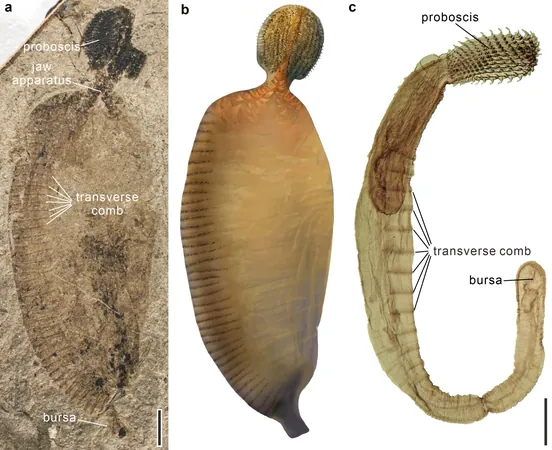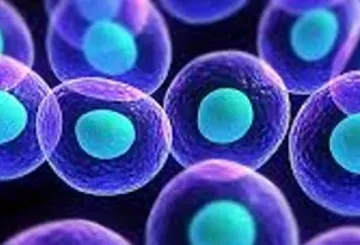
Groundbreaking Discovery: Jurassic Fossil Unlocks Secrets of Thorny-Headed Worm Evolution!
2025-04-09
Author: Jia
Jurassic Gem: Meet Juracanthocephalus!
A remarkable research team from the Nanjing Institute of Geology and Paleontology has made waves in the paleontological world with the discovery of a fossil acanthocephalan named **Juracanthocephalus**, dating back 160 million years to the Daohugou Biota in Inner Mongolia, China. Published in the prestigious journal *Nature*, this jaw-dropping finding casts new light on the enigmatic origins of thorny-headed worms!
The Unseen World of Acanthocephalans
Commonly referred to as thorny-headed or spiny-headed worms, acanthocephalans are fascinating endoparasitic creatures that thrive in various ecosystems—both land and sea. These medically important parasites have a wide-ranging impact, infecting various hosts, including humans, dogs, cats, pigs, and even fish.
Living Mysteries: Evolutionary Debates
With their distinctive worm-like bodies and retractable proboscises lined with hook-like structures, acanthocephalans have sparked significant debate among scientists regarding their evolutionary classification. Historically seen as a separate phylum, their unusual traits have led to numerous hypotheses linking them to flatworms, penis worms, or even wheel animals. However, most molecular studies suggest they belong to a specialized group within Rotifera.
A Fossil Rarity: Uncovering Hidden History
Fossil evidence for acanthocephalans has remained elusive, primarily due to their soft bodies, which are less likely to fossilize compared to harder-bodied creatures. Until now, the only known fossil evidence comprised four possible acanthocephalan eggs found in the coprolites of ancient crocodyliforms.
Cracking the Code: Analyzing Juracanthocephalus
Using advanced scanning electron microscopy (SEM) and energy-dispersive spectroscopy (EDS), the researchers meticulously analyzed Juracanthocephalus. Their findings suggest this ancient worm is a crucial transitional form, bridging the evolutionary gap between free-living, jawed rotifers and their parasitic relatives.
Juracanthocephalus: The Ultimate Endoparasite?
Featuring a fusiform body with a uniquely configured proboscis and the intriguing remains of a potential alimentary tract, this fossil hints that Juracanthocephalus was indeed an endoparasite back in the Jurassic era. It sports double rows of tooth-like clusters in its jaw structure, presenting an evolutionary link to modern acanthocephalans.
Evolutionary Insights: Acanthocephalans and Rotifers
A pivotal discovery, Juracanthocephalus positions itself as a stem-group acanthocephalan, establishing tight connections within the broader evolutionary framework of Rotifera. As scientists delve further, this fossil helps reconcile conflicting theories regarding the phylogenetic placement of acanthocephalans.
Unlocking Earth's Natural History!
The discovery of Juracanthocephalus not only illuminates the evolution of acanthocephalans but also emphasizes the crucial role of transitional fossils in understanding major shifts in animal morphology. As molecular phylogenetics reshapes our understanding of evolutionary ties, Juracanthocephalus stands as a testament to the rich narrative of life's history, suggesting that these fascinating parasites may have emerged from terrestrial roots during the Middle Jurassic!



 Brasil (PT)
Brasil (PT)
 Canada (EN)
Canada (EN)
 Chile (ES)
Chile (ES)
 Česko (CS)
Česko (CS)
 대한민국 (KO)
대한민국 (KO)
 España (ES)
España (ES)
 France (FR)
France (FR)
 Hong Kong (EN)
Hong Kong (EN)
 Italia (IT)
Italia (IT)
 日本 (JA)
日本 (JA)
 Magyarország (HU)
Magyarország (HU)
 Norge (NO)
Norge (NO)
 Polska (PL)
Polska (PL)
 Schweiz (DE)
Schweiz (DE)
 Singapore (EN)
Singapore (EN)
 Sverige (SV)
Sverige (SV)
 Suomi (FI)
Suomi (FI)
 Türkiye (TR)
Türkiye (TR)
 الإمارات العربية المتحدة (AR)
الإمارات العربية المتحدة (AR)